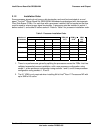
I/O Subsystems Intel® Server Board Set SE8500HW4
Revision 1.0
Intel order number D22893-001
12
Device APIC INTA# INTB# INTC# INTD#
LSI Logic*
53C1030
Intel IOP332 Storage I/O
Processor (A)
PX1A_XINT0_N PX1A_XINT1_N
- -
Intel
®
Fibre
Channel
Module
Intel IOP332 Storage I/O
Processor (A)
PX1A_XINT2_N PX1A_XINT3_N
- -
3.1.2 PCI IDSEL Signal
The IDSEL signal is used as a chip-select for devices during read and write transactions. The
PXH and Intel® IOP332 Storage I/O Processor assert a specific address bit on a given PCI bus
to toggle the IDSEL signal to the PCI device. For the Intel
®
Server Board Set SE8500HW4
Mainboard the address bit to IDSEL mapping is shown in Table 5.
Table 5. IDSEL Mapping
Device Device # IDSEL Host Bridge
Broadcom* BCM5704 2 PX2B_AD<18> PXH (B)
Slot 2 2 PX2A_AD<18> PXH (A)
Slot 6 6 PX1B_AD<22> Intel
®
IOP332 Storage I/O
Processor (B)
Slot 7 7 PX1B_AD<23> Intel IOP332 Storage I/O
Processor (B)
LSI Logic* 53C1030 5 PX1A_AD<21> Intel IOP332 Storage I/O
Processor (A)
Intel
®
Fibre Channel Module 15 PX1A_AD<31> Intel IOP332 Storage I/O
Processor (A)
ROMB enabled on Intel IOP332
Storage I/O Processor
14 n/a Internal to Intel IOP332
Storage I/O Processor
Note: When the ROMB solution is enabled, the IDSEL to the LSI Logic 53C1030 is inhibited by
the Intel
®
IOP332 Storage I/O Processor. This effectively hides the SCSI controller from the
system and the Intel
®
IOP332 Storage I/O Processor acts as the SCSI (or RAID) controller.
Since the Intel
®
Fibre Channel Module is attached to the same bus as the SCSI controller, the
Intel
®
Fibre Channel Module is set to device 15 so that it is not affected by the device hiding
operation required for the ROMB solution.


















